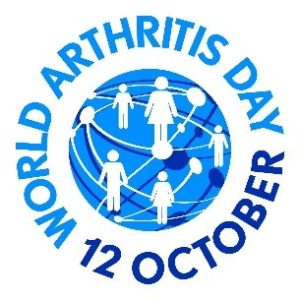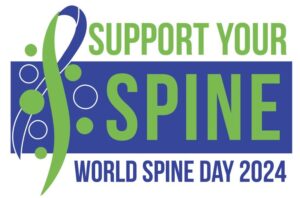Bone & Joint Action Week is our opportunity to highlight the importance of musculoskeletal health and the need to effectively prevent and manage conditions which affect it.
During this week there are dedicated days to highlight major rheumatic and musculoskeletal conditions.
17 October: World Trauma Day
19 October: World Pediatric Bone & Joint Day
The Global Alliance for Musculoskeletal Health encourage active support of the individual days to promote awareness of musculoskeletal conditions.
12 October – World Arthritis Day

World Arthritis Day (WAD) was established in 1996 by Arthritis and Rheumatism International (ARI) and is celebrated each year on 12 October.
Now, people with rheumatic and musculoskeletal diseases (RMDs) from around the world can join together to make their voices heard on this day. World Arthritis Day is an ideal focus for organisations to raise awareness of issues affecting people with RMDs and for individuals to support campaigns.
Although 12 October is the official World Arthritis Day, this is a year round campaign.
The aims of World Arthritis Day are:
-
To raise awareness of RMDs amongst the medical community, people with RMDs and the general public
-
To influence public policy by making decision-makers aware of the burden of RMDs and the steps which can be taken to ease it
-
To ensure all people with RMDs and their caregivers are aware of the vast support network available to them.
The World Arthritis Day website is supported and managed by EULAR, the European League Against Rheumatism and you are invited to share your personal story #ConnectToday about living with a rheumatic and musculoskeletal disease (RMD) and tell the world how you have taken action to:
-
Live your life to the fullest (if you have a RMD)
-
Support people with RMDs (carers, healthcare professionals and the wider public)
16 October – World Spine Day

Every year on October 16th people from around the world join together to raise awareness on World Spine Day as part of the Bone and Joint Decade’s Action Week.
The World Spine Day (WSD) theme for 2024 is “Support your spine” and is a call to action for individuals to prioritise spinal health across all aspects of life. It highlights the importance of staying mobile, avoiding prolonged periods of physical inactivity and refraining from overloading the spines with excessive weight or strain. Additionally, adopting healthy lifestyle choices such as weight loss and smoking cessation can significantly contribute to spinal well-being.
The aims of World Spine Day are to:
-
Raise awareness about spinal health and spine disorders within the interdisciplinary health care community and amongst public policy decision-makers and the general public;
-
To provide an opportunity for and encourage ongoing discussion about the burden of spinal disorders; and
-
To promote an interdisciplinary, collaborative approach to easing the burden of spinal disorders.
17 October – World Trauma Day
World Trauma Day began in 2011 in New Delhi, with The Trauma Society of South Africa (which has the highest road mortality rate in the world with 40 deaths per day) joining the year after. Its purpose was to set a day aside to consider the impact, prevention and treatment of traumatic injuries and deaths.
According to the World Health Organization (WHO), trauma is a major cause of death and disability across the world. WHO research has shown that at least 50 percent of road deaths occurring in developing countries could have been prevented with effective intervention after trauma has occurred, that is:
-
immediate pre-hospital care;
-
adequate knowledge of handling emergency situations (involves training of personnel);
-
adequate supply of pre-hospital care equipment and facilities (enough ambulances and other medical supplies).
Commemoration of World Trauma Day emphasizes the importance of saving and protecting a life during the most critical moments and preparing and applying critical measures to deal with and avoid trauma fatalities.
WHO research has shown that at least 50 percent of road deaths occurring in developing countries could have been prevented with effective interference after trauma has occurred, that is:
-
Immediate pre-hospital care
-
Adequate knowledge of handling emergency situations (involves training of personnel)
-
Adequate supply of pre-hospital care equipment and facilities (enough ambulances and other medical supplies)
19 October – World Pediatric Bone & Joint (PB&J) Day
World Pediatric Bone and Joint (PB&J) Day, developed by the multi-disciplinary Pediatric Specialty Group of the United States Bone and Joint Initiative (USBJI) features educational stories on important bone and joint-related conditions about which kids, adolescents and their parents should be aware.
The United States Bone and Joint Initiative (USBJI) Pediatric Specialty Group’s goal is to identify the primary areas of concern with regard to children’s musculoskeletal health, including those that relate to other health issues, and to develop programs and activities through research, education and advocacy that will promote their improved health, and reduce the burden of disease.
World PB&J Day seeks to highlight the impact of musculoskeletal conditions on children and educate health care providers and the public about children’s musculoskeletal health issues.
-
Nearly 48% of adults have a musculoskeletal condition, many of which began in childhood.
-
Children represent 10% of the population with a disabling musculoskeletal condition.
20 October – World Osteoporosis Day

World Osteoporosis Day (WOD), marked on October 20 each year, is a campaign dedicated to raising global awareness of the prevention, diagnosis and treatment of osteoporosis and metabolic bone disease. It aims to put bone, muscle and joint health on the global health agenda and reaches out to health-care professionals, the media, policy makers and the public at large.
The global campaign has been organised by the International Osteoporosis Foundation (IOF) since 1997. IOF develops the campaign strategy, messaging and toolkit material, which is then rolled out through its over 234 member organizations – comprised of national osteoporosis patient, medical and research societies – in more than 99 countries
The World Osteoporosis Day Theme for 2024 is “Say no to fragile bones”. Under this banner, the campaign seeks to put an end to the inertia surrounding bone health by urging people of all ages to value and protect their bones.
Remember the 5 Steps to better bone health
-
Move your bones – Bones, like muscles, get stronger when you use them
-
Ensure a bone-healthy diet – a balanced diet with adequate intake of calcium, protein, vitamin D, vitamin K and other nutrients
-
Avoid bone-damaging habits – Don’t smoke, avoid excessive alcohol intake and maintain a healthy body weight
-
Prevent recurrent fractures – if you’ve broken a bone after age 50, be assessed to prevent future fractures; falls prevention
-
Know your risk – be aware of personal risk factors – height loss, genetics, medications, diseases, menopause



